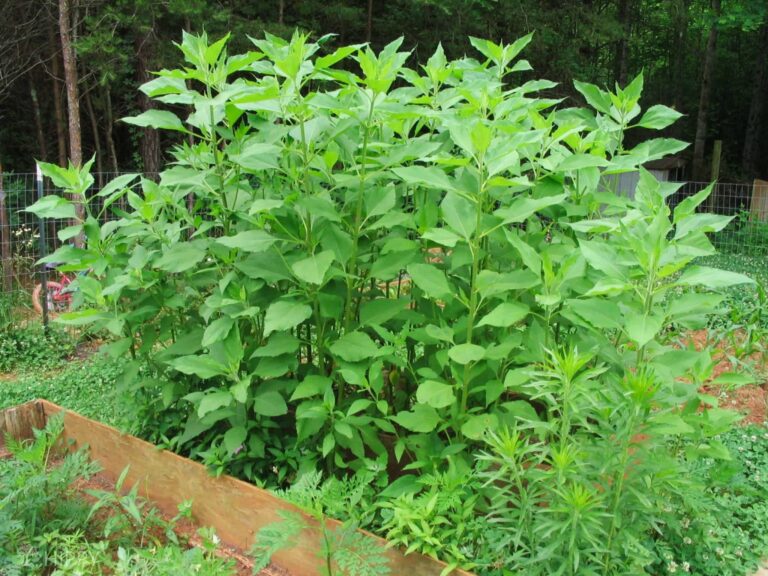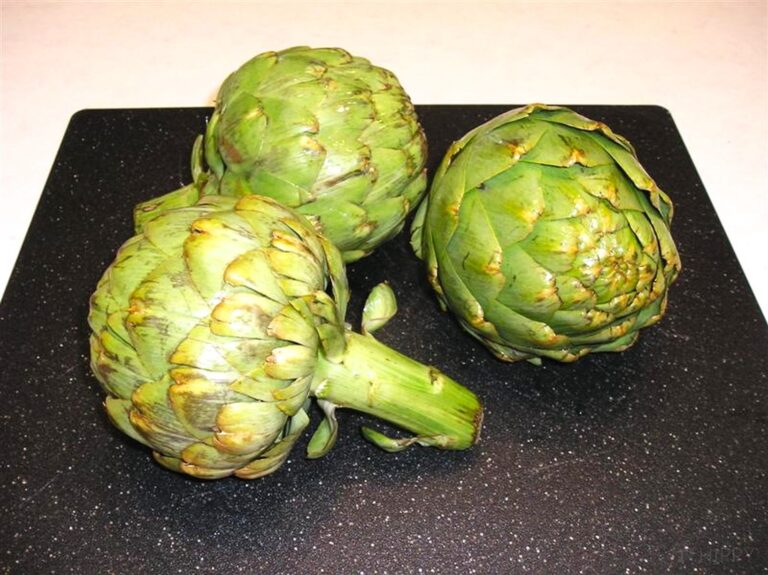Have you ever grown artichokes before? If not, you’re in for a treat! Artichokes are delicious, nutritious vegetables that are relatively easy to grow. And they’re some of my favorite vegetables!

Table of Contents
What Are Artichokes?
Sunchokes, AKA Jerusalem artichokes (Helianthus tuberosus), are a wonderful addition to any homestead garden.
Sunchokes are a tuber, which means they grow from the root itself. Each little sunchoke will develop roots that will create several more sunchokes each year.
Artichokes are actually a type of thistle, and the edible portion is actually the flower of the plant. The globe artichoke is the most common type, and it can be eaten cooked or raw. When raw, artichokes have a slightly sweet taste and a crunchy texture.
When cooked, they become softer and take on a nutty flavor. Artichokes are a good source of fiber, vitamins C and K, and magnesium. They can be steamed, boiled, baked, or grilled.
Artichokes can also be used in soups, salads, pasta dishes, and more. Whether you’re enjoying them as a side dish or using them as an ingredient in a recipe, artichokes are a versatile and delicious option.
Reasons To Grow Sunchokes
Here are some of the main reasons you need to be growing sunchokes in your garden.
(Keep in mind you can also forage for these delicious tubers as they grow in the wild!)
Growing Sunchokes Is Easy
Simply place a tuber piece in the ground, about 3 inches deep, and cover with dirt. This is best done in the fall, but we have also spread them in the Spring.
Once planted, let them grow! In the late summer and early fall, they will have beautiful flowers that look very similar to small sunflowers. Our bees love this food source, particularly as other sources are dying off.
They Can Stay in the Ground Until You Are Ready To Use Them
When you are ready to harvest Jerusalem artichokes, you will simply take a shovelful of dirt and turn it up. You’ll get a handful of chokes nearly every time.
We harvest ours only as we need them, even in the winter. Just mark where you left off, and start there the next time you harvest.
Carefully wash the tuber, and remove any extra roots. Allow to dry a bit, then you are ready to use them!
They Spread by the Roots, With No Further Cultivation Need
When harvesting, just leave a couple behind to let them regrow. One tuber will turn into many the next season, making this an easy garden veggie to grow. It’s almost impossible to kill them, really.
Jerusalem Artichokes Are Healthy and Delicious
Sunchoke flavor is earthy, yet mild. A bit like a starchier potato, without all the heavy carbs. They contain about the same amount of calories, 73 per 100g, with nearly zero fat.
Sunchoke health benefits include” a high level of potassium, iron, and copper. 100 g of fresh root holds 429 mg of potassium.
They also contain 3.4 mg of iron, probably the highest amount of this trace element among the common edible roots and tubers.
Sunchokes also contain small amounts of anti-oxidant vitamins such as vitamin-C, vitamin-A, and vitamin-E. Besides all of this, they are a great source of fiber!
Cons
Some things to keep in mind when growing Jersualem artichokes in your garden:
They Will Take Over the Area
Keep them contained as much as possible, and harvest the outside edges first to help prevent spreading.
Sunchokes can be used in nearly any recipe as a replacement for potatoes. They have a very similar texture to white potatoes and are tasty baked, grilled, or pan fried.
It can be easily transitioned to from their potato alternative. Try mixing 1/2 sunchokes and 1/2 white potatoes in a mashed form for a gradual change.
Best Varieties Grow
Artichokes are a delicious and healthy addition to any garden. With their large, edible hearts and nutritious leaves, artichokes are a versatile vegetable that can be enjoyed in many different ways.
While there are many different varieties of artichokes available, some types are better suited for home gardens than others. When choosing a variety of artichoke to grow, it is important to consider the plant’s size, yield, and resistance to pests and diseases.
One of the best varieties of artichokes to grow at home is the ‘Green Globe’ artichoke. This variety is relatively small, making it well-suited for smaller gardens.
Additionally, ‘Green Globe’ artichokes have a high yield, meaning that gardeners can expect to harvest a good amount of fruit from each plant.
Finally, this variety is resistant to many common pests and diseases, making it a low-maintenance option for busy gardeners.
For those looking for a bigger yield, the ‘Imperial Star’ artichoke is a good choice. This variety produces large fruits that are perfect for using in recipes that call for canned or frozen artichokes. Additionally, ‘Imperial Star’ artichokes are relatively easy to grow, too.

How Long Does it Take to Grow an Artichoke?
If you’re wondering how long it takes to grow an artichoke, the answer isn’t quite as straightforward as you might hope. Artichokes are actually a type of flower, and their growth cycle depends on the climate in which they’re grown.
In general, artichokes take about 80 days to mature, but this can vary depending on the variety of artichoke and the time of year it is planted. For example, early-season varieties of artichoke will mature more quickly than late-season varieties.
Additionally, artichokes planted in warmer climates will typically mature faster than those planted in cooler climates.
So, if you’re interested in growing your own artichokes, be sure to do your research and choose a variety that is well suited to your particular growing conditions.
Do Artichokes Grow Back Every Year?
Artichokes are a perennial plant, meaning they can live for several years and produce artichokes annually.
However, the plant will eventually die off after 3-5 years, at which point you’ll need to replant. Most gardeners choose to replant every year or two to ensure a consistent supply of artichokes.
The good news is that artichokes are relatively easy to grow, so you shouldn’t have any trouble keeping your plants healthy and productive. With a little care and attention, you can enjoy fresh artichokes for many years to come.
When to Plant Artichokes
Artichokes are a delicious and nutritious addition to any garden, but they can be tricky to grow. One of the most important things to know is when to plant them.
Artichokes need a long, cool growing season in order to produce heads that are large enough to eat. They should be planted in early spring, as soon as the soil can be worked and the danger of frost has passed.
If you live in an area with a short growing season, you may need to start your artichokes indoors and then transplant them into the garden later.
Where to Plant Artichokes
Artichokes are a tasty and nutritious addition to any garden, but they can be finicky plants to grow. One of the most important factors in ensuring a successful crop is choosing the right location. Artichokes need full sun for best results, so pick a spot in your yard that gets at least six hours of sunlight each day.
They also prefer well-drained soil, so avoid any areas that tend to stay wet or muddy after a rain.
Once you’ve found the perfect spot, be sure to prepare the soil before planting. Add some organic matter to help retain moisture and loosen up the clay-like soil often found in artichoke growing regions.
The best way to do this is to add compost or well-rotted manure to the soil. This will help to improve the drainage and aeration of the soil, as well as providing essential nutrients that will help the plants to thrive. In addition, it is important to make sure that the soil is not too acidic or alkaline, as this can adversely affect the growth of artichokes. A pH level between 6.0 and 7.0 is ideal.
Once the soil has been prepared, artichoke plants can be planted in early spring, spacing them about two feet apart.
How to Plant Artichokes
Artichokes are delicious, healthy, and relatively easy to grow. However, they do require a bit of extra care when planting. Here are a few tips to ensure a bountiful crop of artichokes:
Artichokes need full sun and well-draining soil. They also prefer slightly acidic conditions, so adding some compost or peat moss to the soil before planting can be helpful.
Deciding whether to start your artichokes from seed or transplant can be a tough decision. If you start from seed, you’ll have to wait longer for your plants to mature, but you’ll have a greater selection of varieties to choose from.
If you transplant, you’ll be able to get your artichokes into the ground sooner, but you’ll be limited to the types of plants that are available.
Ultimately, the best choice for you will depend on your personal preferences and growing conditions. If you’re patient and willing to experiment, starting from seed may be the way to go.
But if you’re looking for a quicker harvest or if you plan on growing artichokes in a colder growing zone, transplanting may be the best option.
To plant artichokes, start by digging a hole that is about twice the size of the root ball. Gently loosen the roots and place the plant in the hole, making sure that the crown is level with the soil surface. Firm the soil around the plant and water well.
Caring for Artichokes
If you are lucky enough to have artichoke plants in your garden, then you know that they require a bit of extra care to keep them thriving. Below, I will share some tips on how to care for your artichokes so that you can enjoy their delicious bounty!
Watering
Artichokes are a drought-tolerant plant, meaning they don’t need much water to survive.
However, they will produce more food if you water them regularly. When growing artichokes, aim to water the plants about once a week. If it hasn’t rained in a while, you may need to water more often. To check if the plant needs water, stick your finger into the soil near the base of the plant. If the soil is dry, it’s time to water. Be sure to give the plant enough water so that the soil is moist but not soggy.
Overwatering can lead to problems such as root rot. Water early in the day so that the leaves have time to dry before nightfall. This will help prevent fungal diseases. With consistent watering, you can enjoy a bountiful harvest of delicious artichokes.
Weeding
Artichokes are a delicious and healthy vegetable that can be enjoyed in many different ways.
However, artichokes can also be difficult to grow due to their susceptibility to weeds. Weeding artichokes is essential for preventing the vegetable from being choked out by competing plants.
The best way to weed artichokes is to carefully hand-pull any unwanted plants as soon as they appear.
This will prevent the weeds from stealing nutrients and water from the artichokes and ultimately killing them. Be sure to pull up the entire weed, roots and all, to prevent it from regrowing.
Fertilizing
One of the most important things to remember when fertilizing artichokes is that they are heavy feeders. They need a lot of nutrients to produce large, tasty buds, so it is important to use a high-quality fertilizer.
When fertilizing artichokes, start early in the season. This will give the plants time to develop a strong root system before they begin producing fruit.
Artichokes also prefer a slightly acidic soil, so it’s important to use a fertilizer that contains sulfur.
Another key to success is to water regularly and deeply, especially during hot summer months. Over-fertilization can lead to leaf burn, so it’s important to follow directions carefully.
Mulching
Mulching helps to keep the soil moist and prevents weeds from competing with your artichokes for water and nutrients. It also helps to insulate the roots from extreme temperatures, protecting them from both heat and cold damage.
To mulch your artichokes, simply spread a layer of organic material (such as straw, leaves, or hay) around the base of the plant.
Be sure to add fresh mulch every few weeks during the growing season, and apply a thick layer in late fall to help protect the plants over winter.
Pests and Diseases
Growing artichokes can be a rewarding experience, but it’s important to be on the lookout for pests and diseases. These problems can quickly get out of hand if they’re not dealt with promptly.
Aphids are a common problem in artichoke plants. These small insects suck the sap from the plants, causing them to weaken and produce fewer artichoke buds.
If you see aphids on your artichokes, try spraying them with water or rubbing them off with your fingers.
Powdery mildew is a type of fungus that affects many types of plants, including artichokes. This problem is characterized by a white, powdery growth on the leaves and stems of the plant
Powdery mildew can be controlled by spraying the plant with a fungicide or by removing affected leaves.
Cutting Back the Plants
After a long growing season, artichoke plants need to be cut back in order to promote new growth.
This can be done by trimming the plants back to about six inches tall. If the plants are too tall, they will produce fewer flowers and fruits. In addition, cutting back artichoke plants helps to encourage bushier growth.
As a result, the plants will produce more leaves, which can be used for cooking or as ornamental features in the garden. Finally, cutting back artichoke plants ensures that the roots receive enough sunlight and air circulation.
Pruning and Dividing
Artichokes are a classic addition to any garden, and with proper care, they can produce bountiful crops for years to come.
One of the most important things to remember when growing artichokes is to prune and divide the plants on a regular basis.
By removing old leaves and stems, artichokes will be encouraged to produce new growth. In addition, dividing the plants every few years will help prevent them from becoming overcrowded and will keep them productive.
Companion Plants for Artichokes
Artichokes are a delicious and versatile addition to any meal, but did you know that they also make a great companion plant?
Companion planting is a method of garden planning that involves choosing plants that will benefit from each other’s presence.
When selecting companion plants for artichokes, look for vegetables that share similar growing requirements, such as full sun and well-drained soil. Artichokes also benefit from being planted near beans, peas, and tomatoes.
These plants produce nitrogen-rich foliage, which helps to fertilize the soil and support the growth of artichokes. In addition, beans and peas can help to support the tall stems of artichokes, making them less likely to fall over in windy weather.

Harvesting Artichokes
Harvesting artichokes can be a bit of a process, but with a few quick tips, you’ll be a pro in no time.
First, it’s important to wait until the artichoke is fully mature – this usually takes about two months. Once it’s ready, cut the stalk about four inches below the flower head. Next, use a sharp knife to trim off any thorns.
Finally, rinse the artichoke under cool water and enjoy!
How to Preserve Artichokes
Artichokes are a delicacy that can be enjoyed fresh or preserved. When selecting artichokes, look for firm, green globes with tight leaves. Avoid artichokes that are yellowing or have wilted leaves.
To preserve artichokes, trim the stem and leaves, then blanch in boiling water for two minutes. Next, place the artichokes in an airtight container and add a mixture of one part vinegar to three parts water.
The artichokes will keep in the refrigerator for up to two weeks.
To enjoy, simply remove the artichoke from the container and steam until tender. Serve with melted butter or your favorite dipping sauce.
Using Artichokes
Artichokes are a delicious and versatile vegetable that can be used in a variety of dishes. One of the simplest ways to enjoy them is to steam or boil the artichokes and then dip them in melted butter or your favorite sauce.
Another option is to stuff them with a mixture of bread crumbs, herbs, and cheese before baking.
Artichokes can also be thinly sliced and added to salads, pasta dishes, or pizzas. Or, for a more unusual recipe, try deep-frying artichokes for a crispy treat.
Whichever way you choose to prepare them, enjoy your fresh-picked artichokes!
Final Thoughts
If you are looking for a fun and productive way to spend your summer, I suggest growing artichokes. They are relatively easy to grow and can be harvested throughout the summer months.
Have you ever planted sunchokes, a.k.a Jerusalem artichokes? Will you try them in your garden? Be sure to pin this for later!

Heather’s homesteading journey started in 2006, with baby steps: first, she got a few raised beds, some chickens, and rabbits. Over the years, she amassed a wealth of homesteading knowledge, knowledge that you can find in the articles of this blog.
Learn more about Heather and the rest of the writers on this page.

I went to a seed exchange at our local library and a vendor gave me some. I had never heard of them before or knew what to do with them. So I planted these in a 5 gallon bucket last year once the flower’s died I pulled up all that I could find even dumped out the bucket. I put the same dirt back in and forgot about it over winter well now new ones are growing in the bucket! Super excited about this. I guess I missed a few last year.
Do you have to peel them?
I do not peel them myself.
I love to eat these in a warm salad with goat cheese, hazelnuts and spinach.
I hope to grow these next year as a winter staple. Thanks for sharing!
This is also a good herbal plant. As what I’ve heard this can cure sickness.